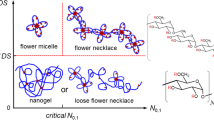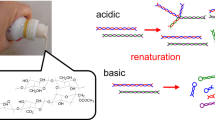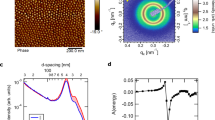Abstract
IT has been proposed1 that polysaccharide shapes in solution might be characterized by the monochromatic optical rotation, using Kauzmann's additivity principle2 to obtain a conformational term, [Λ], which is then analysed according to the methods of Whiffen3 and Brewster4. Experimental evidence does indeed show that the optical rotations of polysaccharides are sensitive to conformation5,6 and, with certain reservations, the interpretation works remarkably well1. For unsubstituted neutral polysaccharides there is no alternative to such an empirical analysis because the rotational strengths on which a more fundamental treatment might be based cannot be measured with present instruments. We now describe some conclusions which emerge for oligo and polysaccharide conformations in aqueous solution.
This is a preview of subscription content, access via your institution
Access options
Subscribe to this journal
Receive 51 print issues and online access
$199.00 per year
only $3.90 per issue
Buy this article
- Purchase on Springer Link
- Instant access to full article PDF
Prices may be subject to local taxes which are calculated during checkout
Similar content being viewed by others
References
Rees, D. A., J. Chem. Soc., B, 877 (1970).
Kauzmann, W., Clough, F. B., and Tobias, I., Tetrahedron, 13, 57 (1961).
Whiffen, D. H., Chem. Ind., 964 (1956).
Brewster, J. H., J. Amer. Chem. Soc., 81, 5483 (1959).
Rao, V. S. R., and Foster, J. F., Biopolymers, 1, 527 (1963).
McKinnon, A. A., Rees, D. A., and Williamson, F. B., Chem. Commun., 701 (1969).
Rees, D. A., J. Chem. Soc., B, 217 (1969).
Rees, D. A., and Scott, W. E., Chem. Commun., 1037 (1969).
Stone, A. L., in Structure and Stability of Biological Macromolecules (edit. by Timasheff, S. N., and Fasman, G. D.), 353 (Dekker, New York, 1969).
Sundaralingam, M., Biopolymers, 6, 189 (1968).
Stone, A. L., Biopolymers, 7, 173 (1969).
Anderson, N. S., Campbell, J. W., Harding, M. M., Rees, D. A., and Samuel, J. W. B., J. Mol. Biol., 45, 85 (1969).
Rees, D. A., Steele, I. W., and Williamson, F. B., J. Polymer Sci., C, 28, 261 (1969).
Aspinall, G. O., Percival, E., Rees, D. A., and Rennie, M., in Rodd's Chemistry of Carbon Compounds (edit. by Coffey, S.), IF, 596 (Elsevier, Amsterdam, 1967).
Bailey, R. W., Oligosaccharides (Pergamon, Oxford, 1965).
Micheel, F., Chemie der Zücker und Polysaccharide (Geest and Portig K.-G., Leipzig, 1956).
Kabat, E. A., Lloyd, K. O., and Beychock, S., Biochemistry, 8, 747 (1969).
Stone, A. L., Childers, L. G., and Bradley, D. F., Biopolymers, 1, 111 (1963).
Author information
Authors and Affiliations
Rights and permissions
About this article
Cite this article
REES, D., SCOTT, W. & WILLIAMSON, F. Correlation of Optical Activity with Polysaccharide Conformation. Nature 227, 390–392 (1970). https://doi.org/10.1038/227390a0
Received:
Issue Date:
DOI: https://doi.org/10.1038/227390a0
This article is cited by
Comments
By submitting a comment you agree to abide by our Terms and Community Guidelines. If you find something abusive or that does not comply with our terms or guidelines please flag it as inappropriate.



